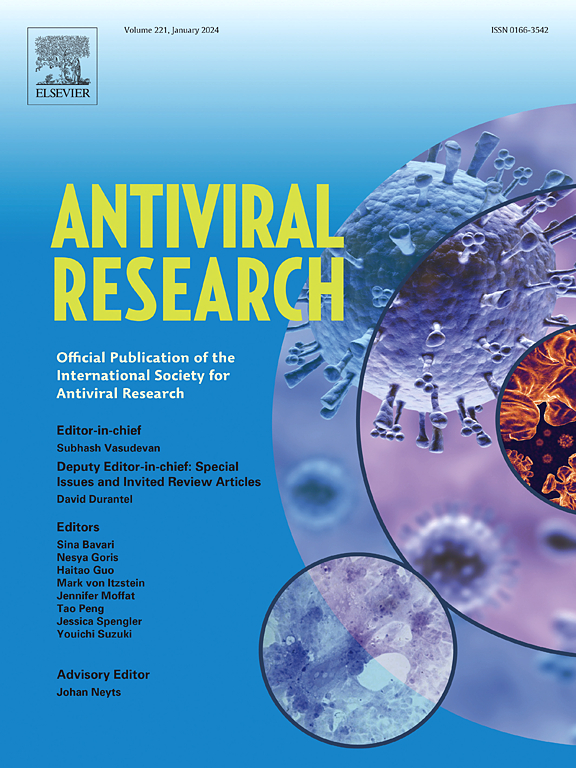Inhibition of influenza A virus proliferation in mice via universal RNA interference
IF 4.5
2区 医学
Q1 PHARMACOLOGY & PHARMACY
引用次数: 0
Abstract
Influenza A virus (IAV) is a respiratory pathogen that causes seasonal outbreaks and periodic pandemics. As frequent mutations in the IAV viral genome often render vaccines ineffective or inefficient in preventing the latest outbreak, there is a need to explore other preventive strategies to control the disease. This study sought to investigate the use of antiviral short hairpin RNA (shRNA), delivered by a recombinant adeno-associated virus (AAV), for the prevention of IAV infections. Conserved regions with less than 10 % of variation were identified from IAV genome sequences deposited in the National Center for Biotechnology Information (NCBI) database between 2000 and 2023. The shRNA targeting these conserved sequences was transcribed from the human RNA polymerase III U6 promoter in an AAV system. This study demonstrates that AAV delivery of shRNA against IAV genes encoding two of the viral RNA-dependent RNA polymerase subunits, PB1 and PB2, inhibits the replication of IAV H1N1 and H3N2 viruses in Madin-Darby canine kidney (MDCK) cells. Delivery of shPB1 to lung tissue in mice through AAV also provided effective protection against IAV infection. These results offer support for a shRNA-based strategy of influenza prevention.

通过通用RNA干扰抑制甲型流感病毒在小鼠中的增殖。
甲型流感病毒(IAV)是一种呼吸道病原体,可引起季节性疫情和周期性大流行。由于IAV病毒基因组的频繁突变往往使疫苗在预防最近的疫情方面无效或效率低下,因此有必要探索控制该疾病的其他预防策略。本研究旨在探讨由重组腺相关病毒(AAV)递送的抗病毒短发夹RNA (shRNA)在预防IAV感染中的应用。从美国国家生物技术信息中心(NCBI)数据库2000 - 2023年存储的IAV基因组序列中鉴定出变异小于10%的保守区域。在AAV系统中,从人RNA聚合酶III U6启动子转录出靶向这些保守序列的shRNA。本研究表明,AAV递送shRNA对抗IAV基因编码的两个病毒RNA依赖的RNA聚合酶亚基PB1和PB2,可以抑制IAV H1N1和H3N2病毒在Madin-Darby犬肾(MDCK)细胞中的复制。通过AAV向小鼠肺组织递送shPB1也能有效保护小鼠免受IAV感染。这些结果为基于shrna的流感预防策略提供了支持。
本文章由计算机程序翻译,如有差异,请以英文原文为准。
求助全文
约1分钟内获得全文
求助全文
来源期刊

Antiviral research
医学-病毒学
CiteScore
17.10
自引率
3.90%
发文量
157
审稿时长
34 days
期刊介绍:
Antiviral Research is a journal that focuses on various aspects of controlling viral infections in both humans and animals. It is a platform for publishing research reports, short communications, review articles, and commentaries. The journal covers a wide range of topics including antiviral drugs, antibodies, and host-response modifiers. These topics encompass their synthesis, in vitro and in vivo testing, as well as mechanisms of action. Additionally, the journal also publishes studies on the development of new or improved vaccines against viral infections in humans. It delves into assessing the safety of drugs and vaccines, tracking the evolution of drug or vaccine-resistant viruses, and developing effective countermeasures. Another area of interest includes the identification and validation of new drug targets. The journal further explores laboratory animal models of viral diseases, investigates the pathogenesis of viral diseases, and examines the mechanisms by which viruses avoid host immune responses.
 求助内容:
求助内容: 应助结果提醒方式:
应助结果提醒方式:


